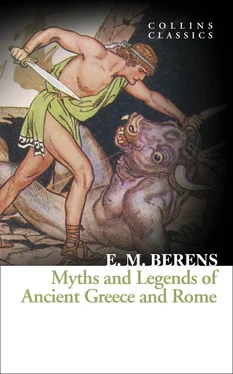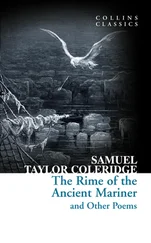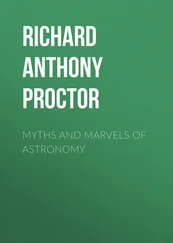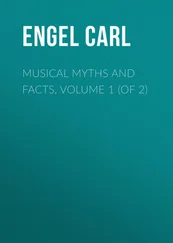The chief seat of the worship of Apollo was at Delphi, and here was the most magnificent of all his temples, the foundation of which reaches far beyond all historical knowledge, and which contained immense riches, the offerings of kings and private persons, who had received favourable replies from the oracle. The Greeks believed Delphi to be the central point of the earth, because two eagles sent forth by Zeus, one from the east, the other from the west, were said to have arrived there at the same moment.
The Pythian games, celebrated in honour of the victory of Apollo over the Python, took place at Delphi every four years. At the first celebration of these games, gods, goddesses, and heroes contended for the prizes, which were at first of gold or silver, but consisted, in later times, of simple laurel wreaths.
On account of its being the place of his birth, the whole island of Delos was consecrated to Apollo, where he was worshipped with great solemnity; the greatest care was taken to preserve the sanctity of the spot, for which reason no one was suffered to be buried there. At the foot of Mount Cynthus was a splendid temple of Apollo which possessed an oracle, and was enriched with magnificent offerings from all parts of Greece. Even foreign nations held this island sacred, for when the Persians passed it on their way to attack Greece, they not only sailed by, leaving it uninjured, but sent rich presents to the temple. Games, called Delia, instituted by Theseus, were celebrated at Delos every four years.
A festival termed the Gymnopedæa was held at Sparta in honour of Apollo, in which boys sang the praises of the gods, and of the three hundred Lacedæmonians who fell at the battle of Thermopylæ.
Wolves and hawks were sacrificed to Apollo, and the birds sacred to him were the hawk, raven, and swan.
The worship of Apollo never occupied the all-important position in Rome which it held in Greece, nor was it introduced till a comparatively late period. There was no sanctuary erected to this divinity until B.C. 430, when the Romans, in order to avert a plague, built a temple in his honour; but we do not find the worship of Apollo becoming in any way prominent until the time of Augustus, who, having called upon this god for aid before the famous battle of Actium, ascribed the victory which he gained, to his influence, and accordingly erected a temple there, which he enriched with a portion of the spoil.
Augustus afterwards built another temple in honour of Apollo, on the Palatine Hill, in which at the foot of his statue, were deposited two gilt chests, containing the Sibylline oracles. These oracles were collected to replace the Sibylline books originally preserved in the temple of Jupiter, which were destroyed when that edifice was burned.
The Sibyls were maidens who had received the gift of prophecy, and the privilege of living to an incredible age. One of these Sibyls (known as the Cumæan) appeared to Tarquinius Superbus, the last king of Rome, offering for sale nine books, which she informed him had been written by herself. Not knowing who she was, Tarquin refused to buy them, upon which she burned three, and returned with six, demanding the same price as before. Being again driven away as an impostor, she again retired and burned three more, returning with the remaining three, for which she still asked the same price as at first. Tarquin, amazed at her inconsistency, now consulted the Augurs, who blamed him for not having bought the nine books when they were first offered to him, and desired him to secure the remaining three, at whatever price they were to be had. He, accordingly, purchased the volumes, which were found to contain predictions of great importance to the Romans. After the disposal of the books, the Sibyl vanished, and was seen no more.
The most beautiful and renowned of all the statues of Apollo now in existence, is that known as the Apollo Belvedere, which was found in 1503 among the ruins of ancient Antium. It was purchased by Pope Julius II., who removed it to the Belvedere of the Vatican, from whence it takes its name, and where it has been, for more than three hundred years, the admiration of the world. When Rome was taken, and plundered by the French, this celebrated statue was transported to Paris, and placed in the museum there, but in 1815 it was restored to its former place in the Vatican. The attitude of the figure, which is more than seven feet high, is inimitable in its freedom, grace, and majesty. The forehead is noble and intellectual, and the whole countenance so exquisite in its beauty, that one pauses spell-bound to gaze on so perfect a conception. The god has a very youthful appearance, as is usual in all his representations, and with the exception of a short mantle which falls from his shoulders, is unclothed. He stands against the trunk of a tree, up which a serpent is creeping, and his left arm is outstretched, as though about to punish.
Hecate would appear to have been originally a moon-goddess worshipped by the Thracians. She became confounded, and eventually identified with Selene and Persephone, and is one of those divinities of whom the ancients had various conflicting accounts.
Hecate was the daughter of Perses and “gold-wreathed” Astræa (the starry night [32]), and her sway extended over earth, heaven, and hell, for which reason she is represented in works of art as a triple divinity, having three female bodies, all young and beautiful, and united together.
In later times, when this divinity becomes identified with Persephone, she is supposed to inhabit the lower world as a malignant deity, and henceforward it is the gloomy, awe inspiring side of her character which alone develops itself. She now presides over all practices connected with witchcraft and enchantments, haunts sepulchres, and the point where two roads cross, and lonely spots where murders have been committed. She was supposed to be connected with the appearance of ghosts and spectres, to possess unlimited influence over the powers of the lower world, and to be able to lay to rest unearthly apparitions by her magic spells and incantations.
Hecate appears as a gigantic woman, bearing a torch and a sword. Her feet and hair are formed of snakes, and her passage is accompanied by voices of thunder, weird shrieks and yells, and the deep baying and howling of dogs.
Her favour was propitiated by offerings and sacrifices, principally consisting of black lambs. Her festivals were celebrated at night, by torchlight, when these animals were offered to her, accompanied by many peculiar ceremonies. These ceremonies were carried out with the minutest attention to details, as it was believed that the omission of the slightest particular would afford to her ministers, the evil spirits of the lower world, who hovered round the worshippers, an opportunity for entering among them, and exerting their baneful influence. At the end of every month food was placed wherever two roads met, in readiness for her and other malignant divinities.
In studying the peculiar characteristics which Hecate assumes when she usurps the place of Persephone, the rightful mistress of the lower world, we are reminded of the various superstitions with regard to spectres, witchcraft, &c., which have, even down to our own times, exerted so powerful an influence over the minds of the ignorant, and which would appear to owe their origin to a remote pagan source.
Just as Helios personified the sun, so his sister Selene represented the moon, and was supposed to drive her chariot across the sky whilst her brother was reposing after the toils of the day.
When the shades of evening began to enfold the earth, the two milk-white steeds of Selene rose out of the mysterious depths of Oceanus. Seated in a silvery chariot, and accompanied by her daughter Herse, the goddess of the dew, appeared the mild and gentle queen of the night, with a crescent on her fair brow, a gauzy veil flowing behind, and a lighted torch in her hand.
Читать дальше












